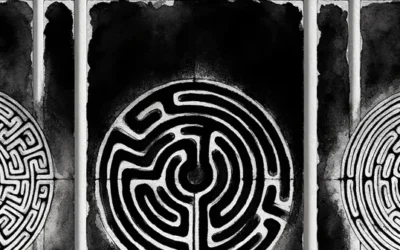
Embracing the Multitudes Within: Understanding Subpersonalities and Parts-Based Therapy
The human psyche is a complex and multifaceted landscape, populated by a diverse cast of characters that shape our thoughts, feelings, and behaviors. These different aspects of our personality, often called “subpersonalities” or “parts,” can work together harmoniously or clash in inner conflict, leading to a sense of internal discord and emotional distress.
The concept of subpersonalities is not new; it has roots in various psychological traditions, from Jungian archetypes to Gestalt therapy’s “top dog” and “underdog.” However, in recent decades, the work of psychologists Sidra and Hal Stone has brought renewed attention to the importance of understanding and integrating these different parts of the self.
In their influential book “Embracing Our Selves: The Voice Dialogue Manual,” the Stones outline a therapeutic approach called Voice Dialogue, which involves directly engaging with and exploring these subpersonalities. The goal is not to eliminate or suppress any parts, but rather to foster greater self-awareness, internal cooperation, and wholeness.
So what exactly are subpersonalities, and how do they develop? According to the Stones’ model, subpersonalities are discrete patterns of thoughts, feelings, and behaviors that emerge in response to our early life experiences and relationships. They are, in essence, different “selves” that we inhabit in different contexts and situations.
For example, a child who grows up with critical or demanding parents may develop a strong “Inner Critic” subpersonality as a way of internalizing and coping with these early messages. This part of the self may become hypervigilant, constantly scanning for flaws and mistakes in an attempt to avoid disapproval or rejection.
Similarly, a child who learns that their emotional needs are not important or valid may develop a “Pleaser” subpersonality that prioritizes the needs and opinions of others over their own. This part may become highly attuned to social cues and work tirelessly to maintain harmony and approval, often at the expense of personal authenticity and self-care.
Other common subpersonalities include the “Pusher,” which drives us to achieve and succeed; the “Rebel,” which resists authority and convention; and the “Vulnerable Child,” which carries our deepest fears, hurts, and longings.
While these parts can serve important protective functions, they can also become rigid and extreme, leading to patterns of thought and behavior that no longer serve us in adulthood. An overactive Inner Critic, for example, can lead to chronic self-doubt, perfectionism, and even depression. An unchecked Pleaser can result in codependent relationships and a loss of personal identity.
Moreover, when these subpersonalities are in conflict – such as when the Pusher is driving us to work long hours while the Vulnerable Child is yearning for rest and connection – we can experience a profound sense of inner turmoil and self-alienation.
Interestingly, these subpersonalities often manifest not just psychologically but also somatically, in our bodies and physical sensations. The Inner Critic, for instance, may be experienced as a tightness in the chest or a clenched jaw. The Pleaser may be felt as a hollowness in the gut or a tendency to slouch and make oneself small.
By tuning into these somatic cues, we can start to identify and differentiate our various subpersonalities as they arise in the moment. This body-based awareness is a key aspect of many parts-based therapy approaches, which recognize the deep interconnection between mind and body.
So how can we start to work with and integrate these different parts of ourselves? The first step, according to the Stones and other parts-based therapists, is simply to cultivate curiosity and non-judgmental awareness. By learning to observe our inner landscape with friendly interest, we can start to map out the different subpersonalities that inhabit it.
This can involve practices like journaling, meditation, or simply pausing throughout the day to check in with ourselves and notice what parts are present. We might ask questions like: What am I feeling right now? What thoughts are running through my mind? What does my body feel like? What part of me is driving my actions in this moment?
As we start to identify and name these different parts, we can begin to engage them in inner dialogue. This is the core practice of Voice Dialogue and similar approaches – literally giving voice to our various selves and allowing them to communicate with each other.
In a Voice Dialogue session, a therapist might guide a client to embody and speak from different subpersonalities, exploring their unique perspectives, needs, and concerns. The therapist may ask questions like: What is your role in this person’s life? What are you afraid of? What do you need to feel safe or fulfilled?
Through this process of respectful inquiry and attentive listening, subpersonalities that have been exiled or in conflict can start to feel heard and understood. The goal is not to get rid of any parts, but to help them work together more harmoniously in service of the person’s overall well-being.
As different parts are allowed to express themselves and have their needs met in healthy ways, the grip of extreme or dysfunctional patterns can start to loosen. The Inner Critic may soften into a voice of realistic discernment. The Pleaser may learn to set boundaries and honor their own desires. The Pusher and the Vulnerable Child may find ways to alternate and cooperate, balancing achievement with rest and play.
Ultimately, parts-based therapy is about cultivating a kind of inner democracy, in which all aspects of the self are valued and included in the decision-making of our lives. It’s about recognizing that we contain multitudes, to paraphrase Walt Whitman, and that true wholeness comes from embracing and integrating all of who we are.
Of course, this is often easier said than done, especially for those of us with a history of trauma, neglect, or marginalization. Some subpersonalities may carry intense pain, shame, or anger that feels overwhelming to encounter. Some may have been so deeply buried that they barely register in our conscious awareness.
This is where the support of a skilled therapist can be invaluable – someone who can hold a safe and compassionate space for all of our parts to emerge and be tended to. Parts-based therapy is a journey of building trust, both internally and interpersonally, and it requires patience, courage, and care.
But the rewards of this inner work are profound. As we learn to embrace our full complexity and contradictions, we can experience a greater sense of self-acceptance, authenticity, and inner peace. We can show up more fully in our relationships and our life’s work, bringing all of who we are to the table.
We can also start to extend this compassionate understanding to others, recognizing that everyone is grappling with their own cast of inner characters. We can approach interpersonal conflicts with more curiosity and less judgment, seeking to understand the parts that are driving someone’s behavior rather than simply reacting to it.
In this way, parts-based therapy is not just a path of personal growth, but also a model for more empathetic and nuanced communication and community-building. By embracing the diversity within ourselves, we can learn to embrace the diversity in the world around us.
As we navigate the challenges and complexities of modern life, this capacity for inner and outer understanding feels more essential than ever. In a world that often feels fragmented and polarized, parts-based therapy offers a hopeful vision of integration and wholeness – a reminder that our differences, both within and between us, can be a source of strength and connection rather than division.
So the next time you find yourself feeling pulled in different directions or stuck in a pattern that no longer serves you, remember that there is wisdom in all of your parts. By turning towards them with curiosity and care, you may just find the key to a more joyful, authentic, and fulfilling life.
Voice Dialogue Subpersonalities Excercises
Sidra and Hal Stone outline several important subpersonalities in their book Embracing Our Selves. What subpersonalities are present in your life? Where are they helping you and where are they holding you back?
The Pusher – The Pusher is the energy pattern behind everything that we accomplish. No matter what we have done it will tell us that we have not done enough. Its job is to move us on to the next thing, no matter what that is. Clean your room, fix the house, stop at the gym, send one more email, stay up for one last Netflix episode.
What does your pusher want you to do to keep moving? Think of some of the things that you do compulsively so that you don’t slow down. Think of the things that you “can’t stop” doing.
Usually when our Pusher is overly active we are avoiding thinking about or feeling something. What is your Pusher avoiding feeling? What do you not like to feel?
If you have a hard time figuring out what your Pusher is avoiding the next time you want to indulge it, don’t do what it wants. Don’t have one more bite, one more drink, take one more sales call. See how you feel when you don’t indulge your Pusher.
Where in your life is the Pusher helping you? Where is it hurting you?
The Inner Critic- The Inner Critic is the energy pattern that finds fault with all of who we are and what we do. After you leave a party the Inner Critic will tell you how stupid everything you said was and how awkward you were. The Inner Critic will often tell you that you do not deserve compliments or have not accomplished enough in life. Learning to turn the Inner Critic into an ally is an important part of reducing anxiety and depression. The Inner Critic will often criticize your performance in religious, professional, social, or familial roles.
What does your Inner Critic sound like? What kinds of criticism does it make?
What does your Inner Critic sound like?
Often when we have critical parent or caregiver our Inner Critic will resemble the way that they spoke to us. The Inner Critic will often sound like a critical parent in its tone but will criticize us about failing to live up to our own values.
Where do you notice this energy pattern in your life?
Does you Inner Critic sound like a parent, sibling, teacher, or someone that you know?
An overly identified Inner Critic can be exhausting. Where in your life is the Inner Critic helping you? Where is it hurting you? Where do you need to ignore it?
The Vulnerable Child – The Vulnerable Child is the energy pattern in touch with all of our needs and all of our fear and vulnerability. It wants to be honest about how much it needs to be cared for. The Vulnerable Child is the first sub personality that we develop. We learn to turn it off in the beginning of our adolescence and often must learn to turn it back on in therapy as adults.
How in touch are you with your Vulnerable Child? Are you comfortable feeling sad and hurt, or are you out of touch with these emotions?
In what places or parts of your life do you feel safe enough to be in touch with asking others for help or admitting that you aren’t ok?
The Pleaser – The Pleaser is the energy pattern that cannot stand to be disliked by anyone for any reason or for any amount of time. In very empathetic individuals The Pleaser sometimes becomes the caregiver and tries to anticipate everyone else’s needs and meet them. Albert Ellis said that it was “pathological to want to be liked by everyone all the time.” The Pleaser is the part of our personality that cannot stand to be disliked, even when we need to confront someone, challenge authority, stick up for ourselves, or realize our life is not what we want it to be. These are things we need to be able to do to be healthy humans.
Do you avoid confrontation? In what parts of your life and why?
What are you afraid will happen if someone dislikes you? What happened when you were disliked before?
What are the parts of yourself that you avoid developing by getting approval from other people?
References
- Stone, H., & Stone, S. (2011). Embracing Our Selves: The Voice Dialogue Manual. Novato, CA: New World Library.
- Gilbert, P. (2014). The Compassionate Mind. London: Robinson.
- Neff, K. D. (2003). The Development and Validation of a Scale to Measure Self-Compassion. Self and Identity, 2(3), 223-250.
- Siegel, D. J. (2012). The Developing Mind: How Relationships and the Brain Interact to Shape Who We Are. New York: Guilford Press.
Additional Resources
For readers interested in learning more about subpersonalities and strategies for inner growth, here are some additional resources:
- Schwartz, R. C. (1995). Internal Family Systems Therapy. New York: Guilford Press.
- Earley, J. (2009). Self-Therapy: A Step-By-Step Guide to Creating Inner Wholeness Using IFS. Larkspur, CA: Pattern System Books.
- Rowan, J. (1993). Discover Your Subpersonalities: Our Inner World and the People in It. London: Routledge.
- Assagioli, R. (2000). Psychosynthesis: A Collection of Basic Writings. Amherst, MA: Synthesis Center.



























0 Comments